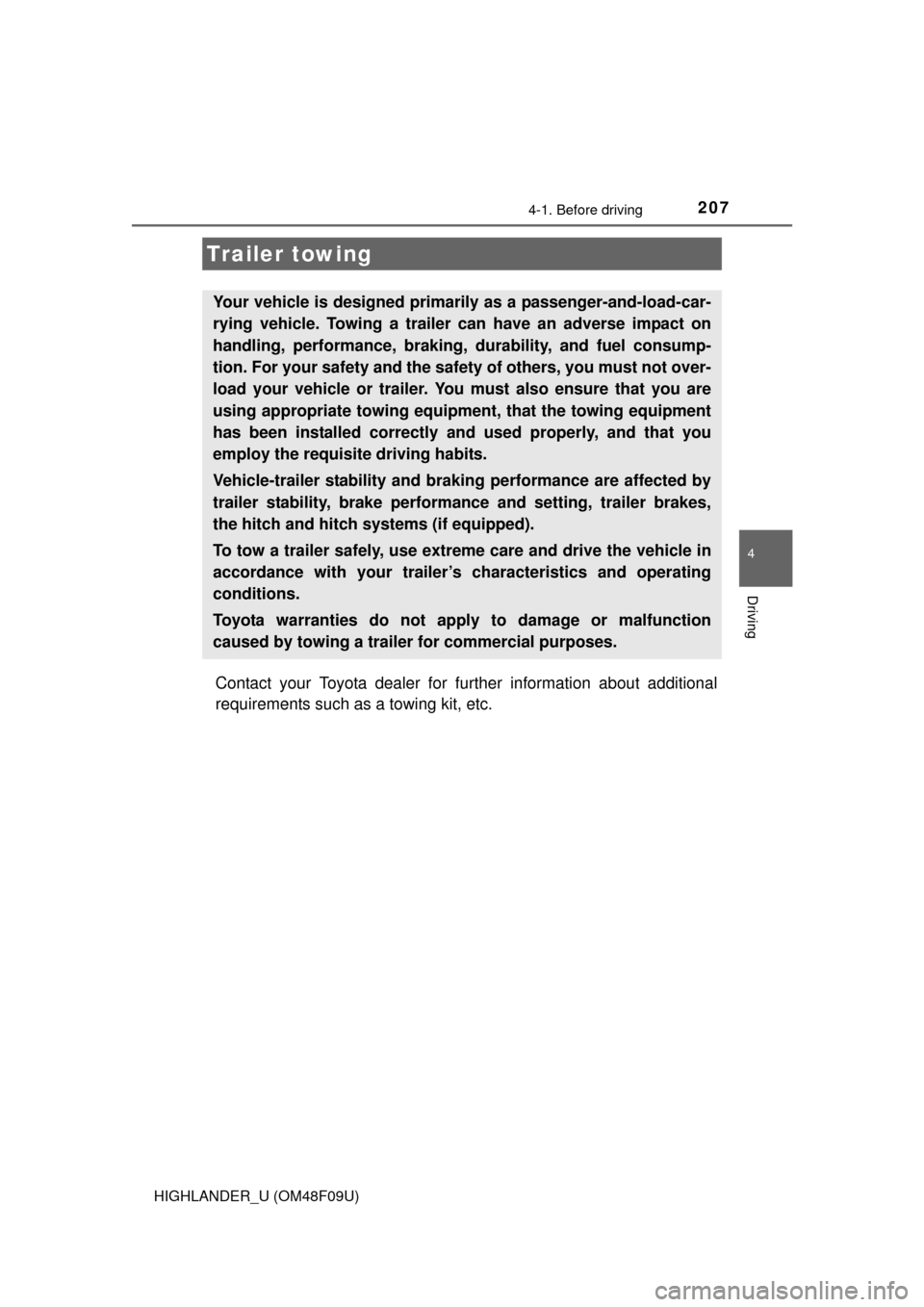Page 207 of 716

2074-1. Before driving
4
Driving
HIGHLANDER_U (OM48F09U)
Contact your Toyota dealer for further information about additional
requirements such as a towing kit, etc.
Trailer towing
Your vehicle is designed primarily as a passenger-and-load-car-
rying vehicle. Towing a trailer can have an adverse impact on
handling, performance, braking, durability, and fuel consump-
tion. For your safety and the safe ty of others, you must not over-
load your vehicle or trailer. You must also ensure that you are
using appropriate towing equipmen t, that the towing equipment
has been installed correctly a nd used properly, and that you
employ the requisite driving habits.
Vehicle-trailer stability and braking performance are affected by
trailer stability, brake performance and setting, trailer brakes,
the hitch and hitch systems (if equipped).
To tow a trailer safely, use extreme care and drive the vehicle in
accordance with your trailer’s characteristics and operating
conditions.
Toyota warranties do not apply to damage or malfunction
caused by towing a trailer for commercial purposes.
Page 209 of 716
2094-1. Before driving
4
Driving
HIGHLANDER_U (OM48F09U)■
GAWR (Gross Axle Weight Rating)
The maximum allowable gross
axle weight. The gross axle
weight is the load placed on
each axle (front and rear).
■TWR (Trailer Weight Rating)
The maximum allowable gross
trailer weight. The gross trailer
weight is the sum of the trailer
weight and the weight of the
cargo in the trailer.
TWR is calculated assuming
base vehicle with one driver,
one front passenger, towing
package (if available), hitch and
hitch systems (if required).
Additional optional equipment, passengers and cargo in the vehicle will
reduce the trailer weight rating so as not to exceed GCWR, GVWR and
GAWR.
If the gross trailer weight exceeds 3000 lb. (1360 kg), it is recommended
to use a trailer with 2 or more axles.
Front GAWR
Rear GAWR
(With brakes)
Page 210 of 716
2104-1. Before driving
HIGHLANDER_U (OM48F09U)■
Unbraked TWR (Unbraked Trailer Weight Rating)
The trailer weight rating for tow-
ing a trailer without a trailer ser-
vice brake system.
■Tongue Weight
The load placed on the trailer
hitch ball. (
P. 214)
(Without brakes)
Page 211 of 716
2114-1. Before driving
4
Driving
HIGHLANDER_U (OM48F09U)
●The gross trailer weight must never exceed the TWR described in
the table. ( P. 212)
● The gross combination weight must never exceed the GCWR
described in the table. ( P. 212)
● The gross vehicle weight must
never exceed the GVWR indi-
cated on the Certification Label.
● The gross axle weight on each
axle must never exceed the
GAWR indicated on the Certifi-
cation Label.
● If the gross trailer weight is over the unbraked TWR, trailer service
brakes are required.
● If the gross trailer weight is over 2000 lb. (907 kg), a sway control
device with sufficient capacity is required.
● If the gross trailer weight is over 5000 lb. (2268 kg), a weight distrib-
uting hitch with sufficient capacity is required.
Weight limits
Page 212 of 716
2124-1. Before driving
HIGHLANDER_U (OM48F09U)
Confirm that the gross trailer weight, gross combination weight, gross
vehicle weight, gross axle weight and tongue weight are all within the
limits.
■GCWR*1 and TWR*1
GCWR, TWR and Unbraked TWR
*1: These models meet the tow-vehicle trailering requirement of SAE Interna-tional per SAE J2807.
*2: The model code is indicated on the Certification Label. (P. 639)
*3: Without a towing package
*4: With a towing package
Model code*2EngineDriving
systemGCWRTWR
ASU50L-ARTNKA
2.7L L4
(1AR-FE) engine
FF6010 lb.
(2725 kg)1500 lb.
(680 kg)
GSU50L-ARTNKA
3.5L V6
(2GR-FE)
engine
FF
6660 lb.
(3020 kg)
*32000 lb.
(900 kg)
*3
9690 lb.
(4395 kg)
*45000 lb.
(2000 kg)
*4
GSU50L-ARTMKA
3.5L V6
(2GR-FE)
engine
FF
6720 lb.
(3045 kg)
*32000 lb.
(900 kg)
*3
9740 lb.
(4415 kg)
*45000 lb.
(2000 kg)
*4
GSU50L-ARTGKA
3.5L V6
(2GR-FE)
engine
FF
6760 lb.
(3065 kg)
*32000 lb.
(900 kg)
*3
9780 lb.
(4435 kg)
*45000 lb.
(2000 kg)
*4
Page 213 of 716
2134-1. Before driving
4
Driving
HIGHLANDER_U (OM48F09U)■
Unbraked TWR*1
1000 lb. (450 kg)
GSU55L-ARTNKA
3.5L V6
(2GR-FE)
engine
AWD
6820 lb.
(3090 kg)
*32000 lb.
(900 kg)
*3
9840 lb.
(4460 kg)
*45000 lb.
(2000 kg)
*4
GSU55L-ARTMKA
3.5L V6
(2GR-FE)
engine
AWD
6880 lb.
(3120 kg)
*32000 lb.
(900 kg)
*3
9900 lb.
(4490 kg)
*45000 lb.
(2000 kg)
*4
GSU55L-ARTGKA
3.5L V6
(2GR-FE)
engine
AWD
6920 lb.
(3135 kg)
*32000 lb.
(900 kg)
*3
9940 lb.
(4505 kg)
*45000 lb.
(2000 kg)
*4
*1: These models meet the tow-vehicle trailering requirement of SAE Interna-
tional per SAE J2807.
*2: The model code is indicated on the Certification Label. (P. 639)
*3: Without a towing package
*4: With a towing package
Model code*2EngineDriving
systemGCWRTWR
Page 218 of 716

2184-1. Before driving
HIGHLANDER_U (OM48F09U)
●As stopping distance is increased when towing a trailer, vehicle-to
vehicle distance should be increa sed. For each 10 mph (16 km/h)
of speed, allow at least one vehicle and trailer length.
● Avoid sudden braking as you may skid, resulting in the trailer jack-
knifing and a loss of vehicle contro l. This is especially true on wet or
slippery surfaces.
● Avoid jerky starts or sudden acceleration.
● Avoid jerky steering and sharp turns, and slow down before making
turn.
● Note that when making a turn, the trailer wheels will be closer than
the vehicle wheels to the inside of the turn. Compensate by making
a wider than normal turning radius.
● Slow down before making a turn, in cross winds, on wet or slippery
surfaces, etc.
Increasing vehicle speed can destabilize the trailer.
● Take care when passing other vehicles. Passing requires consider-
able distance. After passing a vehicle, do not forget the length of
your trailer, and be sure you hav e plenty of room before changing
lanes.
● To maintain engine braking effici ency and charging system perfor-
mance when using engine braking, do not put the transmission in
D. If in the S mode, the transmission shift range position must be in
4 or lower.
● Instability happens more frequently when descending steep or long
downhill grades. Before descending, slow down and downshift. Do
not make sudden downshifts while descending steep or long down-
hill grades.
● Avoid holding the brake pedal down too long or applying the brakes
too frequently. This could cause th e brakes to overheat and result in
reduced braking efficiency.
Page 219 of 716
![TOYOTA HIGHLANDER 2016 XU50 / 3.G Owners Manual 2194-1. Before driving
4
Driving
HIGHLANDER_U (OM48F09U)
●Due to the added load of the trailer, your vehicle’s engine may over-
heat on hot days (at temperatures over 85 F [30C]) when drivin TOYOTA HIGHLANDER 2016 XU50 / 3.G Owners Manual 2194-1. Before driving
4
Driving
HIGHLANDER_U (OM48F09U)
●Due to the added load of the trailer, your vehicle’s engine may over-
heat on hot days (at temperatures over 85 F [30C]) when drivin](/manual-img/14/6425/w960_6425-218.png)
2194-1. Before driving
4
Driving
HIGHLANDER_U (OM48F09U)
●Due to the added load of the trailer, your vehicle’s engine may over-
heat on hot days (at temperatures over 85 F [30C]) when driving
up a long or steep grade. If t he engine coolant temperature gauge
indicates overheating, immediately turn off the air conditioning (if in
use), pull your vehicle off the road and stop in a safe spot.
( P. 632)
● Always place wheel blocks under both the vehicle’s and the trailer’s
wheels when parking. Apply the pa rking brake firmly, and put the
transmission in P. Avoid parking on a slope, but if unavoidable, do
so only after performing the following:
Apply the brakes and keep them applied.
Have someone place wheel blocks under both the vehicle’s and
trailer’s wheels.
When the wheel blocks are in pl ace, release the brakes slowly
until the blocks absorb the load.
Apply the parking brake firmly.
Shift into P and turn off the engine.
● When restarting after parking on a slope:
With the transmission in P, start the engine. Be sure to keep the
brake pedal depressed.
Shift into a forward gear. If reversing, shift into R.
Release the parking brake and brake pedal, and slowly pull or
back away from the wheel blocks. Stop and apply the brakes.
Have someone retrieve the blocks.
1
2
3
4
5
1
2
3
4